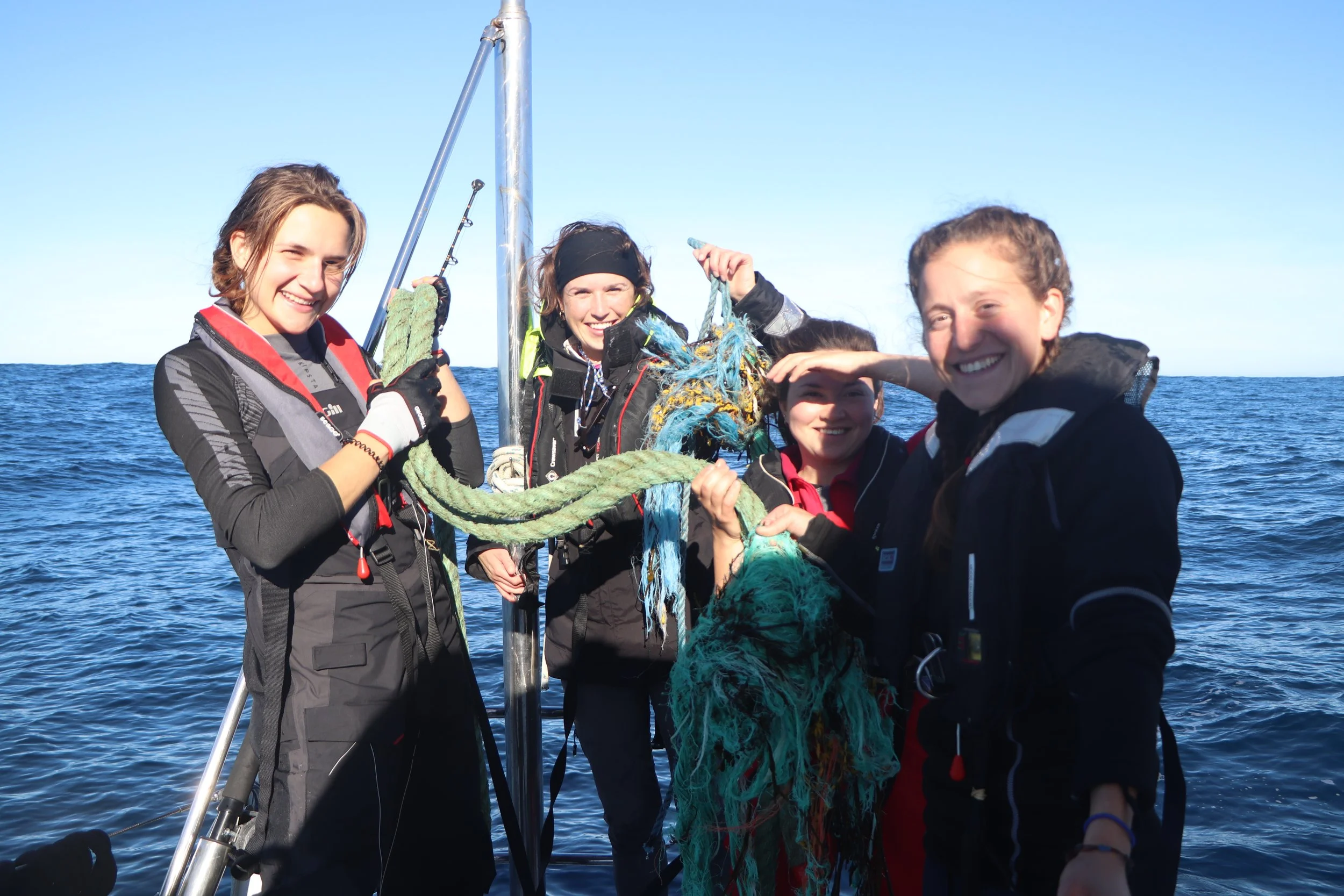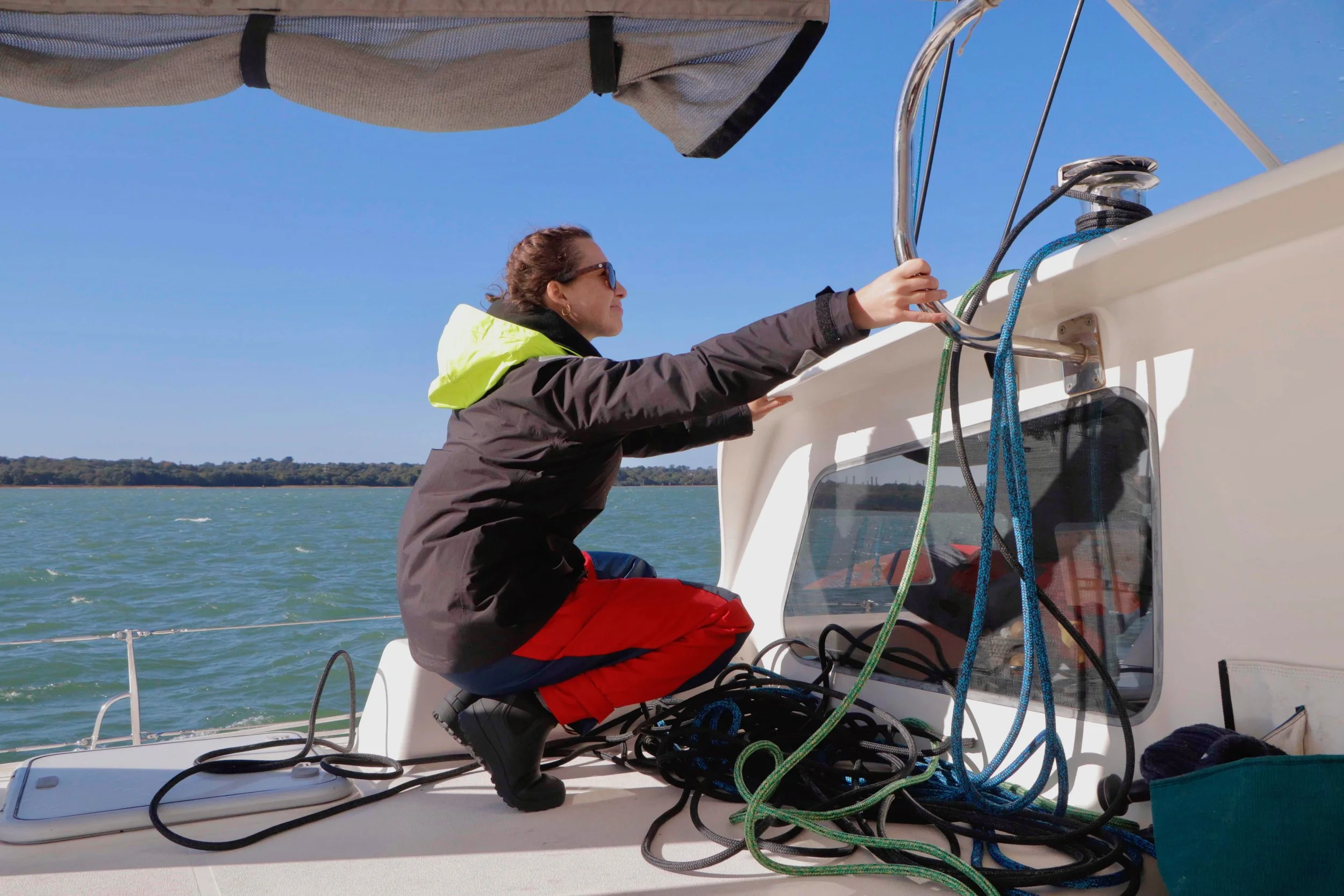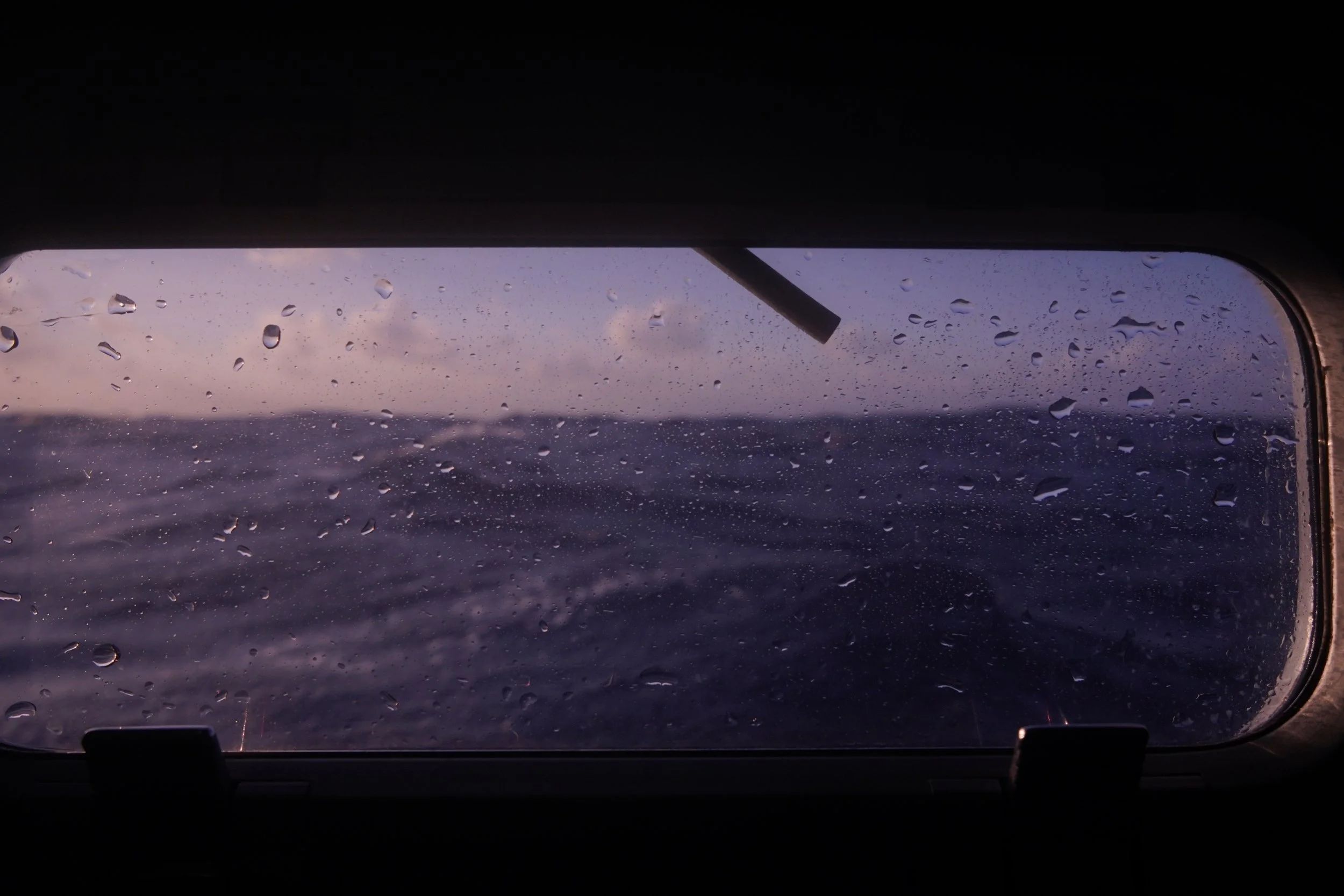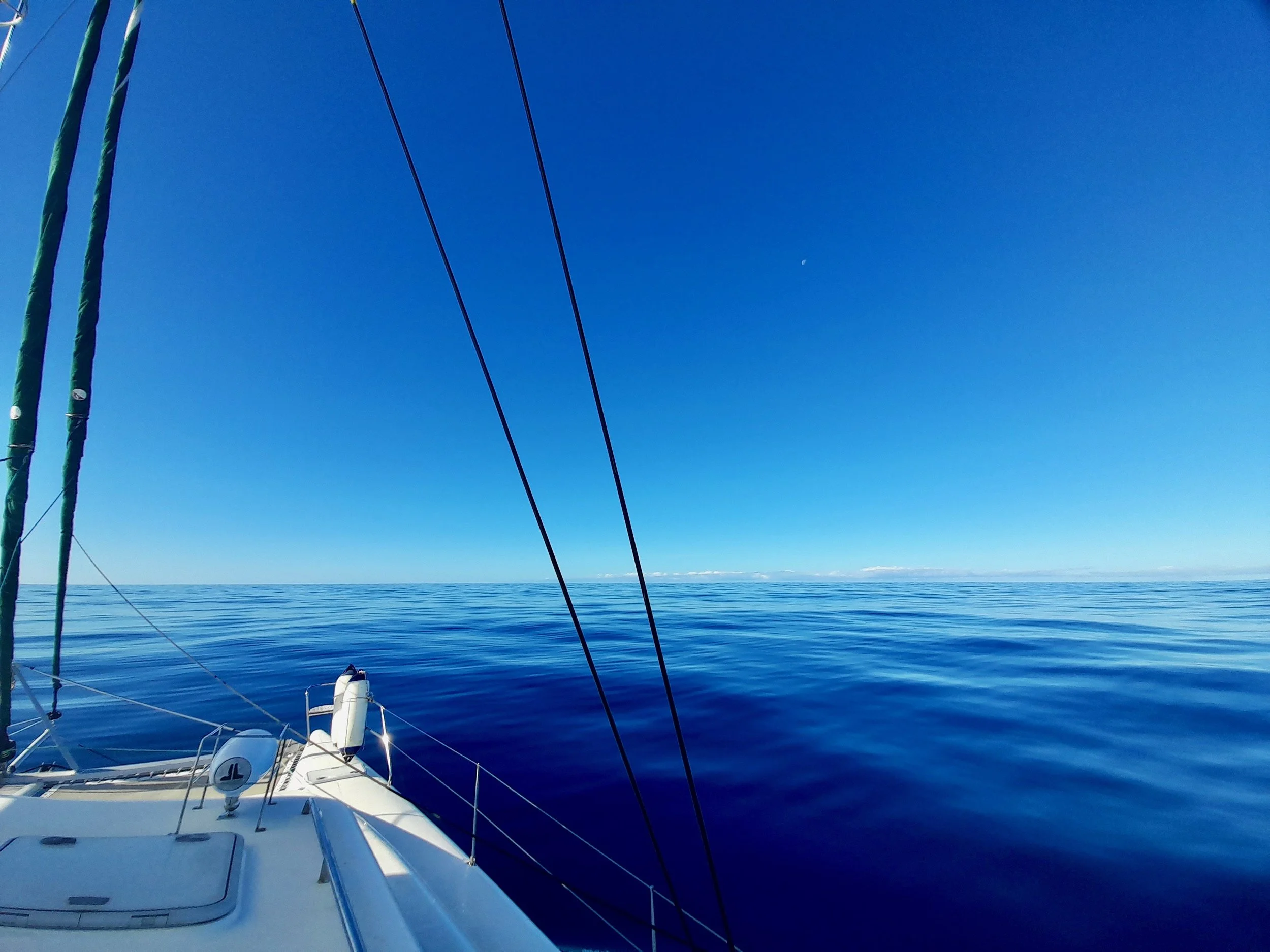WOMEN AT SEA: Our 1,700 mile sailing journey from Southampton to Lanzarote
The crew L to R: Pim (21), Lydia (26), Naomi (28), Captain Sophie (29). Aisha (24) is taking the picture.
Words by Lydia Paleschi . 10-minute read.
In 2020, I quit my job and joined a boat I found online. Eventually, I would stay onboard for 6 months, sailing almost 7,000 miles. This blog documents the first leg of the trip – a 1,700 mile journey from Southampton to Lanzarote, where we would prepare for our Transatlantic crossing. The owner of the boat was unable to come for health reasons, so his friend – 29 year-old Sophie (AKA an absolute badass) – took on the challenge of being skipper. It was an eventful journey, as it was Sophie’s first time captaining and the rest of us had next to no sailing experience. The weather was rough and at times it was damn scary. Looking back it wasn’t the most responsible decision I’ve made, but it was definitely one of the best experiences of my life.
The journey took us south from Southampton, past France, Biscay, Spain, Portugal and Morocco to the Canary Islands (as indicated by the black line).
Departure – Thursday 21st October
The wait is over. As we cast off from the dock, we turn our faces ahead and towards the winding channel of the Itchen River. The brisk October wind whistles past our faces and ears, making our eyes sting and our noses run. Week’s worth of preparation have paid off and as we wave farewell to the guys at the boatyard and the owner of the boat on a borrowed Voyage 500 catamaran named Heaven’s Door, some of us shed tears of joy. It’s a big moment for us. It’s the first time for each of us being part of an all-female crew and Sophie’s first time sailing as skipper, both of which we’re immensely excited about. Just two days previous we’d met Tracy Edwards and the new Maiden crew and we’re feeling even more inspired and motivated as a result.
With our excitement comes trepidation. Only Sophie and I have completed multi-day sails before and we know the weather forecast isn’t great. We’re late in the season and have been warned by some friends to hang fire for better weather, but Sophie has spotted a window and we’ve decided to take it. We know we’re in for a bumpy ride and will have to sail strategically as we travel 1,700 nautical miles across the channel, past Biscay and south towards the Canary Islands.
We met Tracey Edwards and the Maiden crew a couple of days before departure.
A couple of hours after departure we’re halfway to the Isle of Wight, where we break free from the bosom of the land and into the bustling strait of the Solent. The sunset arrives to swaddle what remains of the day in gold and lilac. Meanwhile, the fluffy cumulus transitions from cloud to shadow, creating an attractive silhouette against the sky’s tantalising palette. I head to bed in preparation for my first night watch of the trip and the atmosphere feels as buoyant as a fender bobbing atop the water. It feels great to know the journey has begun and that we’ll be sailing in oceanic waters soon.
The English Channel – Friday 22nd October
It turns out that Heaven’s Door is a noisy boat. I awake from my less than restful slumber feeling like I’ve been sleeping next to a hyperactive sledgehammer. I ascend to the saloon to take over my watch. It’s 3 am, there’s a decent breeze and we’ve got one reef in the main and the genoa. We’re sailing southwest with wind coming from the northeast, the penalty being that Pim – our usually playful French crewmate – has succumbed to vertigo-like waves of sea sickness already. For the next three days, a slightly more pallid version of her lies across the saloon couch, her closest companions a mop bucket and a roll of toilet paper. The rest of us are experiencing tiredness of our own, the customary adjustment to any crossing.
Departing Itchen after hoisting the mainsail.
So far, the sailing has been better than expectedand we feel satisfied that we’re on our way to warmer climes – escaping the cold winters of northern Europe, in favour of sun-kissed beaches and glorious sailing underneath the zenith of the sun. Our speed fluctuates between a healthy six and nine knots, despite going against a relentless two knot current. As we make our way determinedly towards Brest, dodging colossal cargo ships and the unpredictable movements of fishing vessels, we experience our first setback. We turn the motor on and our starboard engine falls victim to a stray fishing net, which lodges firmly around the propellor. Fortunately, because we’re sailing by catamaran, we’re able to continue on our way without calling for assistance. However, the mass of rope and whatever is attached to it creates drag, slowing us down and preventing Heaven’s Door from reaching her full potential.
Celtic Sea – Saturday 23rd October
As we emerge from the channel and into the rippling grey of the Atlantic, I witness my first sunrise since departing. The tentative fingers of dawn have begun to creep above the horizon line and the sky is a mellow fusion of candy floss yellows and pinks. I bid my final mental farewells to the UK and we hurtle out of the channel past Brest at 8 knots, altering our course to west. The weather models are telling us that there’s a storm coming our way from that very direction, and we’ve made the decision to head straight for it as quickly as possible. That way we can avoid being blown into the snarling clutches of Biscay when it hits and hopefully skirt around its edges before heading south.
Sunrise over Itchen as we head towards the Solent.
Throughout the day we make impressive headway and as the wind rises we put a second reef in the main and the genoa. Our plan is to reach the other side of Biscay by Tuesday, where we’ll catch the last of the northerlies and make a swift passage downwind to Lanzarote. As the darkness returns, the wind increases. We tack to port, changing our course to south and brace ourselves for the westerlies. They arrive and are soon over 30 knots. One by one we make our way below in a bid to grab some sleep whilst we can. We need to make sure we’re well rested in anticipation for a rough ride.
Bay of Biscay – Sunday 24th October
I awaken for my shift at 3am and vomit immediately. Heaven’s Door feels like a rollercoaster as the wind and waves throw her about like a plaything. I reassure myself that boats are built to float and assume my position at the chart table. Pim is sprawled on one part of the sofa, Sophie is on the other. The motion sickness is taking hold of us all as we’re violently sideswiped by 4 metre waves. Naomi decides to hang around for half an hour after her watch has ended in case I need her support or feel too ill. I’m grateful as I know she must be exhausted and once I’ve adjusted to the tumultuous motions, I encourage her to go down and get some rest.
Pim suffered from bad sea sickness for the first few days of the trip and again after rough weather.
Objects fly around the room, onions are flung from the macrame hanger, heavy baskets and boxes slide along the floor and Pim’s sick has gone everywhere. We can’t see much outside and to be honest I’m not sure I want to. When I check the instruments I can see we’ve got prolonged winds of 35 knots and I can feel that the waves are big. I stay in the saloon as much as possible, watching the navigation instruments vigilantly and using my life jacket to clip myself onto the cockpit every fifteen minutes as I step outside to scan our surroundings. Each time I leave the shelter of the cabin I’m sodden by huge sprays of water coming from the starboard side and whilst it’s exhilarating, I also can’t wait for it to end. As the night draws on we continue south, racing across the continental shelf and into deeper water. There’s little we can do other than keep an eye on things and wait it out, hoping that we’ll escape the worst of it soon.
Galicia – Tuesday 25th October
It’s been three days since we last saw land and twelve hours since the storm passed. As we near the northern coast of Spain we can see the silhouette of Galicia rise and fall on our port side, little more than a shadow. The sky is clear without a cloud in sight and Pim helps us to identify Jupiter and Saturn, picking them out from the constellations which shine brightly down from an ebony canvas. The pearly white of the moon glimmers on the surface of the water which now gently rolls with less than half a metre of swell. It’s a lovely experience and I take a second to appreciate the beauty of it.
Rolling seas outside of the hull window. Photography never does the size of the waves justice.
We’re using our one motor, travelling at six knots and heading towards A Coruña. By the time we’re past the headland it looks like there isn’t as much wind as we’d hoped for. An hour later and it becomes clear it won’t be pushing us south as quickly as we thought. By the early hours there’s no wind at all and we turn off the engine to preserve fuel. We sit becalmed, 40 miles from the Spanish coast and drift slowly backwards for a while. It sinks in that we’ve missed the northerlies we were so eager to reach and that we need to develop a new plan of action. We feel a little deflated, whilst also being grateful to take a break from the relentless hammering of the elements. It feels strange that the ocean, previously a chaotic mass of churning waves and breaking white crests, has barely a ripple upon its surface. All signs of what we’ve been through have disappeared, along with the wind.
Becalmed – Wednesday 26th October
The next day, we reassess the charts and Sophie decides to wait rather than go back on the motor. The sun is shining valiantly, providing perfect conditions to go for a swim and we use it as a chance to get a long overdue wash. We’re nervous, as this part of the Atlantic has been getting a bad rep lately, with dozens of reports of orcas attacking sailing boats. We know that they could be in the area and this — combined with the fact there are almost 3,000 metres of water below us — makes us feel excited and a little apprehensive. Nonetheless, the call of the ocean and our desire to refresh proves irresistible and we strip off before plunging ourselves into the deep blue of the Atlantic. It’s somewhere around 20 degrees, much warmer than the cold waters of the UK at this time of year, and we take it as an opportunity to look at what’s jamming the propellor.
Becalmed off the coast of Portugal after several days of rough seas.
We spend an hour in the ocean wearing snorkel masks, whilst using a bread knife to try and remove the fishing line. Naomi, Sophie and I hold our breath, swimming below the water level and attempt to saw at the fibres, now a plastic-y green mess. All the while we’re accompanied by a tiny black and white fish who swims up to us inquisitively. As we look around, the only other thing we can see is blue and the occasional refractions of light as they penetrate the water from above. We remove huge clumps of line and a buoy, however the smaller strands are firmly lodged, refusing to come out from between the blades. After trying to prise them out with our fingers we eventually call it a day, happy we’ve made at least some progress. As we clamber out of the water and return to the deck, we hose off with a sprinkling of freshwater and it feels great to know we’re clean again. We turn in for the evening feeling relaxed and content, hoping that the wind will return soon.
Portugal – Saturday 30th October
After a few more days, we’ve made our way steadily south past Spain and the sandy expanses of Portugal’s coastline. The lights from the mainland are barely visible and we’re tired after spending twenty-four hours sailing into wind. Pim and Sophie have resumed their positions on the sofa, once again suffering from lethargy and sea sickness. We’re in the midst of another night of 35 to 40 knot wind speeds, sailing into a gale which is blowing relentlessly from the southwest.
The rope we got caught around our propellor in the English Channel.
Before long, our next challenge presents itself. The anchor has become dislodged from the bow and is no longer secured within the tipper. Naomi has spotted it through the window of the head on port side, its outline a fizz of bioluminescence, swinging through the blackish water in between the hulls. She alerts Sophie, who peels herself from the sofa, and attempts to bring it back up with the windlass remote. We assume it will be a simple enough job, however the sound of clunking metal tells us otherwise and we suspect that somewhere in the chain locker a link is trapped. Knowing we’ll need to go up on deck we peer outside, and as our eyes adjust to the inky tones of the night, we see the waves crashing over the bow. We decide to wait for the light to return before making another attempt, hoping that the situation doesn’t deteriorate. As we continue to sail into the hungry-looking waves the bow slams into them, making a horrendous din as we go.
By mid-morning we watch our captain as she moves across the deck crouching low, determined to maintain her balance. Sophie opens the chain locker in the hope of identifying what’s preventing the windlass from working. As she does so, the clutch slips. We look at one another helplessly as a hundred metres of chain free falls into the depths of the ocean. Our speed less than halves to three knots instantaneously, even though we’re in the midst of 25 knot winds. As the metallic clang comes to a halt and the chain completes its exit, Heaven’s Door groans. The mass of galvanised steel begins to swing like a pendulum beneath her, creating an unnerving, almost ghoulish, sound. It sinks in that we now need to find a way to haul around 350 kilogrammes of metal back on deck, without being able to use the windlass – or lose the anchor. Heaven’s Door sounds like she could rip apart at any moment. She feels uncomfortable and unnatural as she moves through the ocean under strain.
Captain Sophie on deck, whilst Heaven’s Door sails into wind.
Recovering the anchor – Sunday 31st October
Halloween is spent using two halyards to winch the chain up 1 to 2 metres at a time. Fortunately, Heaven’s Door has recently had electric winches installed and with their assistance we take it in turns clipping and unclipping the halyards. We use them alternately to lift the chain and then keep it secure as we reattach the next one ready to lift again. I can’t help but think what I’d be doing if I’d stayed back home, perhaps relaxing with friends over a beer or attending a fancy-dress party. However, as we continue working and begin to make progress, I realise there’s nowhere I’d rather be than digging deep with my crew mates and finding a solution to our current setback. The sun appears from behind the last of the clouds and the ocean calms. Our spirits are elevated, but we maintain our focus. It takes us four hours and 55 winch pulls to get the anchor back into place. The day is turning to dusk when we hear the satisfactory clink of it settling into the tipper. We’re overcome with relief. We tie off the anchor with what feels like a hundred bowlines, adamant that it won’t slip into the ocean again. We head back inside with smiles on our faces, satisfied that there has never been a more secure anchor in the world.
Aisha, Lydia (me) and Pim on deck preparing to salvage the anchor.
Arrival – Friday 5th November
For the remainder of the trip, our main challenge is a multitude of fishing buoys dotted sporadically around twenty miles from the west African coast. We’re cautious of the tiny green lights which are floating in anything from tin cans to milk bottles, as we need to protect our port motor. However, it feels manageable when compared with the events we’ve overcome in the prior parts of our journey and we avoid any too-close encounters. The weather continues to improve and for the first time since departing, the wind seems to be blowing in our favour. We’ve reached the Canaries current and some delicious northerlies which are guiding us generously towards our destination.
As we near the arid landscape of the volcanic islands, the wind drops to less than ten knots and we’re able to enjoy downwind sailing under the power of the code zero – our biggest sail. We furl the genoa and let down the main before settling on deck to watch the sail fill. Within moments we begin to glide across the glistening water. We’re able to truly relax and to get a taste of all the things we came here for — warm weather, pleasant sailing, reading books surrounded by the ocean and getting to know people we never would have met otherwise. As we spot the curvature of the land, the chaos of the past two weeks already seems to have begun to dissipate, melting into memory. Soon it will fade to little more than an adventure of the past and a good story to tell our friends when we next see them.
Overjoyed as we approach the Canaries. L to R me, Sophie and Naomi.
Nearing the marina, the realisation hits that we’ve successfully made the crossing and smiles spread across our faces as we recount all the things we’ve learnt along the way. We radio the office, excited by the prospect of having access to our first shower in two weeks, and request assistance in locating our berth. Within the hour a small inflatable motorboat is headed towards us and as we step onto the deck, its occupants ask to speak with the captain. Sophie announces herself and bemused expressions cross their faces. They’re surprised there isn’t a man on board, even more so by the fact we have a young female captain. As we spend the next two weeks in Lanzarote, making the necessary repairs to Heaven’s Door in preparation for our Transatlantic crossing, this continues to be a common theme. Nonetheless, we prepare for the next leg of the trip with renewed confidence and an excitement to continue our journey together. Meanwhile, I recognise that a seed has been planted and that I am already yearning for another oceanic adventure.
Like to follow my adventures? Sign up to my newsletter so that you don’t miss a blog.
Want to work with me? Get in touch for more information on my freelance writing services.











